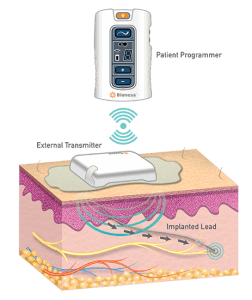

The current work sought to validate whether LTD can be induced within this clinical population employing an LFS technique and explore the potential efficacy of a non-invasive approach only to elicit LTD-related pain suppression. Low frequency stimulation through a transcutaneous-applied, small spherical electrode possible of inducing LTD has been explored in two uncontrolled trials but remains untested within controlled clinical trials. In clinical trials, surgical forms of peripheral nerve stimulation do not consistently utilise low frequency stimulation, whilst the design of low frequency transcutaneous electrical nerve stimulation (TENS) electrodes renders them less suitable for the induction of LTD at a tolerable stimulation level. Induction of LTD via low frequency stimulation should therefore aptly target persistent painful peripheral nerve injury through lowering enhanced gain in nociceptive pathways, however data about the operation of LTD and the effect of low frequency stimulation in these patients is lacking. In rodent models, reversal of nerve-injury induced LTP is achieved through low frequency peripheral nerve stimulation which induces the counterbalancing process of ‘long term depression’ (LTD) where central nociceptive synaptic connections become actively weakened low frequency stimulation also reverses high-frequency stimulation-induced nociceptive LTP in uninjured animals, and healthy man. Experimental nociceptive LTP has been successfully established in humans by modelling the injury-related discharge through focal high-frequency electrical stimulation which facilitates long-lasting hypersensitivity specifically for mechanical stimuli. This initiates an amplification of synaptic transmission in nociceptive pathways termed ‘nociceptive long-term potentiation’ (LTP), which is a pain-related variant of a ubiquitous mechanism of synaptic memory. In rodent models of peripheral nerve injury which feature somatosensory profiles similar to those seen in nerve injury patients, abnormal impulses arising from peripheral nociceptors lead to enhanced pain-responsiveness of spinal cord dorsal-horn neurons. Neuropathic pain arising from peripheral nerve injury is typically associated with positive sensory signs such as dynamic mechanical allodynia or pinprick hyperalgesia, features thought to reflect the sensitization of central pain pathways. Classification of neuropathic pain syndromes, using quantitative sensory testing (QST) has defined patterns of loss or gain of function across sensory modalities (‘somatosensory profiles’) which may reflect underlying pain generating mechanisms. Neuropathic pain can arise either peripherally or centrally as a direct consequence of a lesion or disease affecting the somatosensory system. Taken together results add to mechanistic understanding of LTD and help inform future study design and approaches to treatment. Results from the mechanistic study provide new evidence for effective induction of LTD in a clinical population. Results from the RCT failed to reach significance. (2) In the mechanistic study (n = 19) primary outcomes of mechanical pain sensitivity (p = 0.006) and dynamic mechanical allodynia (p = 0.043) significantly improved indicating reduced mechanical hyperalgesia. Two non-device related serious adverse events were reported. The primary outcome was not significant, pain scores were 0.3 units lower in active group (95% CI − 1.0, 0.3 p = 0.30) giving an effect size of 0.19 (Cohen’s D). (1) 76 patients were randomised (38 per group), with 65 (31 active, 34 sham) included in the intention to treat analysis.
#Peripheral nerve stimulator trial
(2) On trial completion, consenting subjects entered a mechanistic study assessing somatosensory changes in response to LFS. The primary outcome was average pain intensity (0–10 Likert scale) recorded over 1 week, at 3 months, compared between study groups.

(1) Patients were randomised using a concealed, computer-generated schedule to either active or sham non-invasive low-frequency nerve stimulation (LFS), for 3 months (minimum 10 min/day). Two interlinked studies (1) A patient-assessor blinded, randomised, sham-controlled clinical trial and (2) an open-label mechanistic study, sought to examine therapeutic LTD for persons with chronic peripheral nerve injury pain. Induction of long-term synaptic depression (LTD) is proposed as a treatment mechanism for chronic pain but remains untested in clinical populations.


 0 kommentar(er)
0 kommentar(er)
